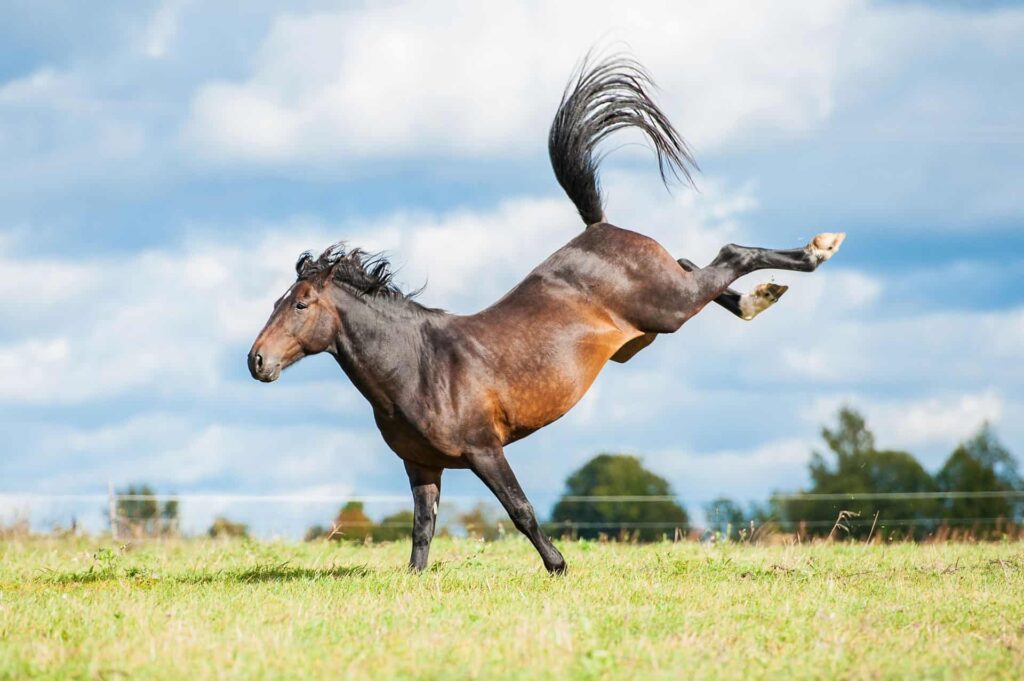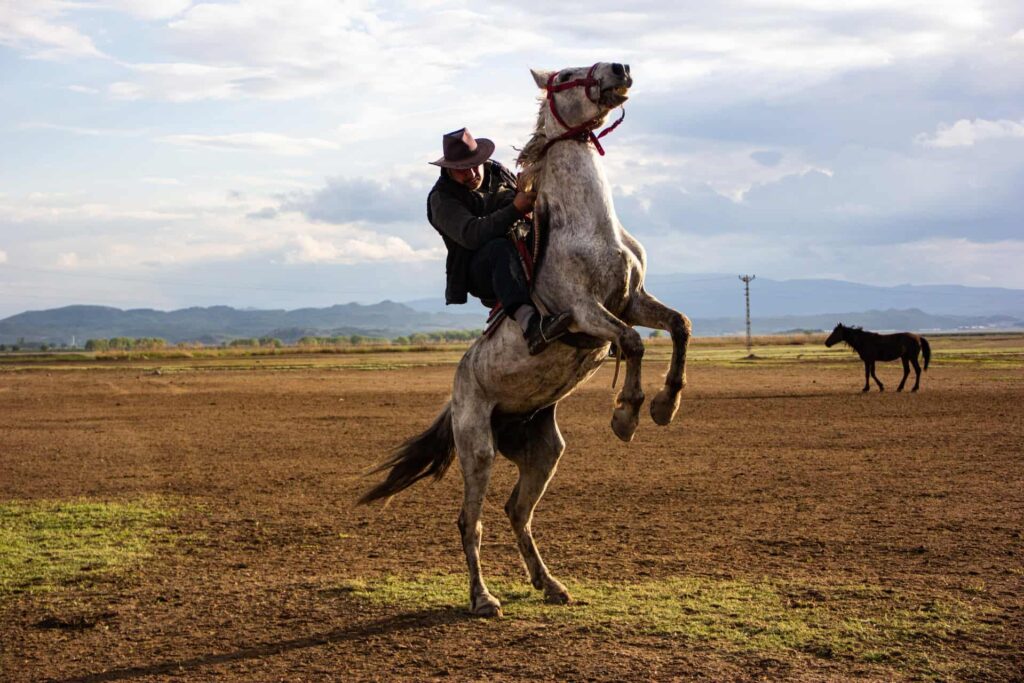Understanding why horses kick is important for anyone involved with these powerful and majestic animals. Horses communicate through a variety of body language cues, and kicking is one of their most expressive actions. A horse kick can convey a range of messages from fear or agitation to assertiveness over resources or boundaries. In the equine world, kicking isn’t just an aggressive action; it can also be defensive, serving as a natural response to perceived threats or an expression of discomfort.
Factors that lead to a horse kicking can stem from temperament, past experiences, or their current environment. For instance, a horse may kick when defending itself against another horse that gets too close, when irritated by pests, or if it’s experiencing pain. Recognizing the precursors to kicking, like pinned ears or a swishing tail, in conjunction with an understanding of equine behavior, is essential for safe interactions. Effective management, training techniques, and a proper understanding of equine welfare are integral to minimizing the risk of kicking incidents.
Key Takeaways
- Kicking serves as a critical form of communication and defense in horses.
- Various reasons for kicking include expressions of discomfort, self-defense, and territory assertion.
- Safe interaction with horses hinges on recognizing their body language and understanding their behavior.
Understanding Horse Behavior
To manage and interact safely with horses, one needs to comprehend their behavior, which is rooted in their instincts as prey animals and their complex social structures.
Natural Instincts and Herd Hierarchy
Horses, as prey animals, have evolved behaviors that prioritize their survival. The herd hierarchy or pecking order is crucial, with natural leaders—often a dominant mare—dictating the group’s movements. This structure supports the survival of the fittest philosophy, where each member knows its place and role in the collective defense against predators.
Body Language and Communication
Understanding horse behavior involves reading their body language, a prime mode of communication. Signs like a swishing tail or pinned ears can indicate irritation while rubbing hips and legs might imply familiarity and trust. They rely on non-verbal cues to express a range of sentiments, from discomfort to harmony within the herd.
Kick as Playful or Aggressive Response
A kick from a horse can convey different messages. For young horses playing, a playful kick is common, exemplifying their attempt to engage with peers. Conversely, a kick can be a defensive mechanism against perceived threats, demonstrating self-defense or aggression.
Signs of Discomfort and Pain
When horses experience discomfort or pain, such as from colic or physical injuries like lacerations and bruises, their behavior changes. Kicking may be a horse’s way to signal pain or discomfort, signaling the need for immediate attention from caregivers.
Social Interaction and Hierarchy
In horse herds, social interaction is governed by a strict hierarchy. The interactions, including kicking, are influenced by the herd’s dynamics, with a boss mare often taking the leadership role. Recognizing each horse’s place within this social structure is essential for understanding their behaviors.
Understanding Horse Language
To truly understand horse behavior, one must ‘speak’ horse. This means recognizing the subtleties of equine communication, from the slight flick of ears to full-fledged movements like kicking; each action has a specific meaning within the context of their environment and society.
Safety Around Horses
When around horses, safety is paramount. Awareness of the flight or fight instinct lessens risk. Safety precautions such as watching body language, and wearing helmets, and other protective equipment cannot be overstressed. Always approach with calm confidence to reduce the likelihood of triggering a defensive response.

Training and Handling
When dealing with horses, the importance of establishing a foundation of proper training and handling cannot be overstated. Utilizing the correct techniques and training equipment increases safety for both the handler and the horse, reduces the likelihood of kicking, and fosters a cooperative relationship.
Foundation of Proper Training
Proper training of horses typically involves multiple sessions with a professional horse trainer to ensure the horse learns appropriate behaviors. The round pen method is a common approach, creating a controlled environment where the horse can focus on the trainer’s cues without external distractions. Mastering basic ground exercises is crucial as they establish respect and teach the horse to respond to commands, which is essential for reducing incidents of kicking or other aggressive behaviors.
Handling Techniques
Effective handling is key to maintaining a safe space for both horses and their handlers. Proper handling requires consistency, patience, and a clear communication of expectations. Handlers should always approach horses with confidence and calmness to avoid triggering a defensive reaction. Teaching horses to lead, stop, and move at the handler’s behest are fundamental skills that ensure control and minimize the risk of behavioral issues.
Using Training Equipment
Utilizing training equipment such as kicking chains can offer a tactile response to discourage kicking habits. The chains are designed to create a mild, uncomfortable sensation when the horse attempts to kick, thus discouraging the behavior over time.
However, this and any other training equipment should be introduced gently and under the guidance of a professional to prevent causing fear or pain, which could exacerbate the problem rather than resolve it.

Health and Care
The well-being of a horse significantly affects its behavior, with pain or discomfort often leading to kicking. A responsible approach to health and care combines preventative measures and prompt attention to emergencies.
Preventing and Identifying Pain or Discomfort
Preventive care is crucial in mitigating the risk of horses kicking due to discomfort. This includes routine check-ups and consistent training which teaches horses how to behave calmly and respond to handlers. Identifying signs of pain or irritation early can prevent negative reactions such as kicking. Look for subtle changes in posture, responsiveness, and signs of agitation like pinned ears or tail swishing.
Biting flies, for instance, can cause significant irritation, leading to kicking. The use of protective gear like fly sheets or repellent can help in prevention. A horse showing signs of discomfort should be examined to determine if there is an underlying health issue that needs care.
Emergency Care and Precautions
In emergencies, such as when a horse sustains broken bones or experiences acute pain, immediate veterinary care is needed. Handlers must prioritize safety and avoid scenarios where a negative reaction could lead to violence. The use of sedatives under veterinary guidance may be necessary to safely administer care and prevent the horse from harming itself or others.
Death or serious injury can sometimes be averted with prompt and appropriate emergency care. Always remain neutral and avoid punishment since it can exacerbate the horse’s fear and pain, potentially leading to more aggressive behaviors.
Interacting with Horses
When interacting with horses, understanding their body language and communication cues is paramount for safety and establishing a respectful relationship. One must be adept at reading signs of fear or aggression to manage and avoid potentially dangerous situations such as being kicked.
Reading and Responding to Horse Cues
Horses communicate their emotions and intentions largely through body language, which includes ear positioning, tail swishing, and overall posture. Recognizing signs of discomfort or fear, such as a horse stomping or ears pinned back, is crucial as these can precede a defensive kick. The key is to respond appropriately by giving the horse space or calmly addressing the source of its anxiety.
Managing and Avoiding Kicks
Effective prevention of horse kicking involves consistently practicing safe handling techniques. One should approach a horse at its shoulder rather than directly from behind, speak softly to signal one’s presence, and observe the horse’s reactions closely.
If a horse does strike forward or seems poised to kick, it’s advised to move away calmly and give the horse time to settle. Understanding the reasons behind kicking, like establishing dominance or reacting to pain, can inform safer interaction methods.
Horse Kick Final Thoughts
Horse behavior is complex, yet understanding why horses kick can help in preventing injuries and fostering safe interactions. Kicks are a form of communication, arising from:
- Self-Defense: Horses are prey animals by nature. When a horse feels threatened, its instinctual response is to protect itself, often resulting in a kick if escape isn’t an option.
- Communication: Horses express discomfort, irritation, or warnings through kicks. It may convey a message to keep a distance or articulate a need.
- Pain or Discomfort: Unseen physical issues may cause a horse to kick. Vice versa, observing kicking behaviors might be a clue to underlying health problems.
Recognizing warning signs is crucial. A horse exhibiting pinned ears, a swishing tail, or restlessness might indicate a need for space or expressing discomfort. Interpreters of equine behavior advise on the importance of noticing these signals to circumvent miscommunications.
Respecting a horse’s personal space and approaching them calmly can reduce the likelihood of kicking incidents. Proper socialization and training also contribute to minimizing this behavior. Familiarity and trust between a horse and a handler can make a profound difference.
Safety is pivotal when interacting with these powerful animals. Horse kicks can have serious consequences, thus, clear understanding and vigilant observation, combined with a respectful approach, are key aspects in ensuring a secure environment for both horses and humans.
Frequently Asked Questions
This section addresses common queries about equine behavior, specifically focusing on the causes and management of kicking in horses.
What situations can cause a horse to kick?
A horse may kick in response to discomfort, irritation, or as a powerful form of communication. Situations such as feeling threatened, defending resources, or experiencing pain can trigger this behavior.
What are effective methods to prevent a horse from kicking?
Preventing a horse from kicking involves recognizing signs of distress and maintaining clear communication. Training and consistent discipline are crucial, as is ensuring the horse is not provoked or startled.
How can one safely discipline a horse that has a habit of kicking?
Safe discipline starts with understanding why the horse kicks and then addressing that behavior calmly and consistently. Correction should be immediate and may involve redirecting the horse’s attention or isolating them safely until they calm down.
What does it signify if a horse kicks out during riding?
A horse kicking out during riding suggests discomfort, such as from ill-fitting tack or back pain, or it may signal a behavioral issue. It’s important to address the root cause rather than just the kicking itself.
In what circumstances might a horse kick a person, and how can this be avoided?
A horse might kick a person if feeling threatened, during feeding times, or when protecting a foal. Avoiding such incidents involves understanding horse body language, giving horses space when they’re agitated, and approaching them in a non-threatening manner. (source)
Why might a horse kick or bite, and what does this behavior indicate?
Kicking and biting are commonly associated with asserting dominance, expressing discomfort, or signaling fear. Recognizing these actions as forms of communication can unveil the horse’s emotional or physical state, assisting in better handling and care.
Last Updated on December 6, 2023 by Nate Dewsbury



